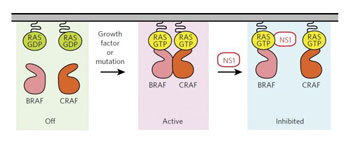Experimental Monobody Drug Inhibits Most Mutated RAS Oncogenes
By Gerald M. Slutzky, PhD
Posted on 17 Nov 2016
A novel monobody drug candidate was found to effectively block the action of most of the RAS family of proto-oncogenes, which are mutated in nearly 90% of pancreatic cancers and are also highly prevalent in colon cancer, lung cancer, and melanoma.Posted on 17 Nov 2016
About a fourth of melanomas are caused by mutations in the N-RAS gene (neuroblastoma RAS viral oncogene homolog), but patients with this type of cancer have had no effective therapeutic options. Furthermore, mutations in the RAS family of proto-oncogenes (comprising H-RAS, N-RAS, and K-RAS) are very common, being found in 20% to 30% of all human tumors.

Image: The NS1 monobody binds to H-RAS or K-RAS protein and blocks RAS function by disrupting the protein\'s ability to form active molecular pairs (Photo courtesy of Dr. John P. O\'Bryan, University of Chicago).
Investigators at the University of Illinois, Chicago (USA) reported in the November 7, 2016, online edition of the journal Nature Chemical Biology that they had developed NS1, a synthetic binding protein (monobody) that bound with high affinity to both GTP- and GDP-bound states of H-RAS and K-RAS but not N-RAS.
Monobodies are synthetic binding proteins that are constructed using a fibronectin type III domain (FN3) as a molecular scaffold. Monobodies are simple and robust alternative to antibodies for creating target-binding proteins. Monobodies are generated from combinatorial libraries in which portions of the FN3 scaffold are diversified using molecular display and directed evolution technologies. A major advantage of monobodies over conventional antibodies is that monobodies can readily be used as genetically encoded intracellular inhibitors, which means that the researcher can express a monobody inhibitor in a cell of choice by simply transfecting the cell with a monobody expression vector. This is possible due to the unique characteristics of the underlying FN3 scaffold: small (only about 90 residues), stable, easy to produce, and its lack of disulfide bonds makes it possible to produce functional monobodies regardless of the redox potential of the cellular environment, including the reducing environment of the cytoplasm and nucleus. In contrast, most antibodies and antibody fragments depend on disulfide bonds formation and they must be produced under an oxidizing environment.
The investigators reported that NS1 was a potent inhibitor of growth factor signaling and oncogenic H-RAS- and K-RAS-mediated signaling and transformation but did not block oncogenic N-RAS, BRAF (v-Raf murine sarcoma viral oncogene homolog B), or MEK1(Mitogen-activated protein kinase kinase).
NS1 bound the alpha4-beta6-alpha5 region of RAS, which disrupted RAS dimerization and nanoclustering and led to blocking of oncogenic CRAF–BRAF heterodimerization and activation. These results established the importance of the alpha4-beta6-alpha5 interface in RAS-mediated signaling and defined a previously unrecognized site in RAS for inhibiting RAS function.
"We did not look for a drug or specifically for an inhibitor," said senior author Dr. John O'Bryan, associate professor of pharmacology at the University of Illinois, Chicago. "We used monobody technology, a type of protein-engineering technology, to identify regions of RAS that are critical for its function. The beauty of the technology is that when a monobody binds a protein, it usually works as an inhibitor of that protein."
"Development of effective RAS inhibitors represents a "holy grail" in cancer biology," said Dr. O'Bryan. "We now have a powerful tool we can use to further probe RAS function. While future studies and trials are needed before these findings can be leveraged outside the lab, this study provides new insight into how we can potentially inhibit RAS to slow tumor growth."
Related Links:
University of Illinois, Chicago













